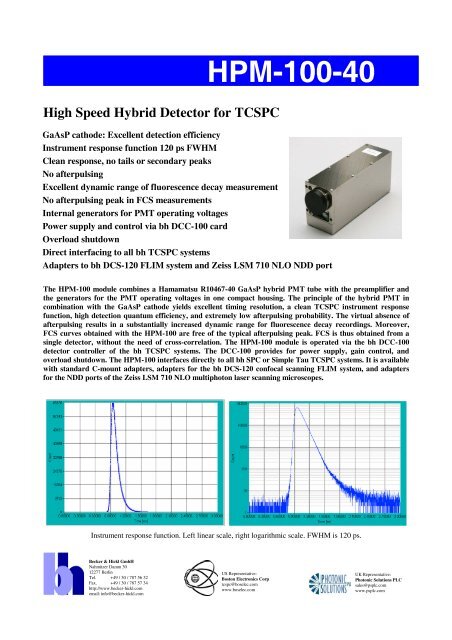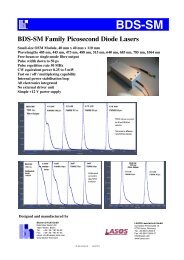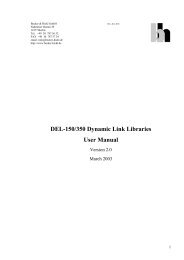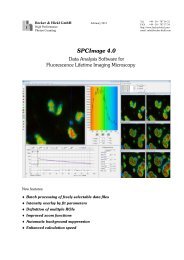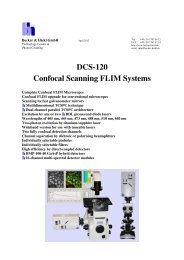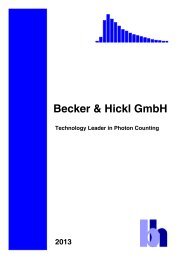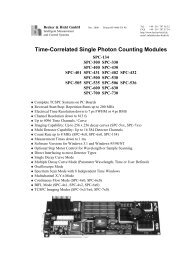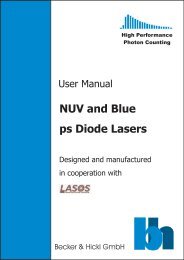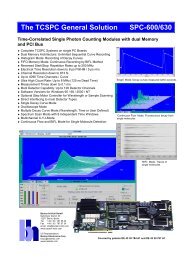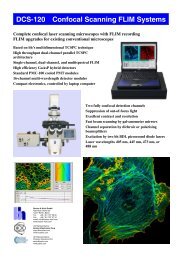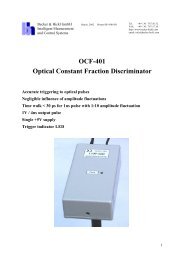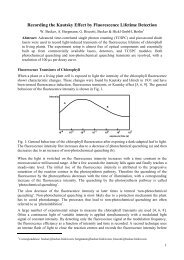HPM-100-40 - Becker & Hickl GmbH
HPM-100-40 - Becker & Hickl GmbH
HPM-100-40 - Becker & Hickl GmbH
You also want an ePaper? Increase the reach of your titles
YUMPU automatically turns print PDFs into web optimized ePapers that Google loves.
High Speed Hybrid Detector for TCSPC<br />
<strong>HPM</strong>-<strong>100</strong>-<strong>40</strong><br />
GaAsP cathode: Excellent detection efficiency<br />
Instrument response function 120 ps FWHM<br />
Clean response, no tails or secondary peaks<br />
No afterpulsing<br />
Excellent dynamic range of fluorescence decay measurement<br />
No afterpulsing peak in FCS measurements<br />
Internal generators for PMT operating voltages<br />
Power supply and control via bh DCC-<strong>100</strong> card<br />
Overload shutdown<br />
Direct interfacing to all bh TCSPC systems<br />
Adapters to bh DCS-120 FLIM system and Zeiss LSM 710 NLO NDD port<br />
The <strong>HPM</strong>-<strong>100</strong> module combines a Hamamatsu R10467-<strong>40</strong> GaAsP hybrid PMT tube with the preamplifier and<br />
the generators for the PMT operating voltages in one compact housing. The principle of the hybrid PMT in<br />
combination with the GaAsP cathode yields excellent timing resolution, a clean TCSPC instrument response<br />
function, high detection quantum efficiency, and extremely low afterpulsing probability. The virtual absence of<br />
afterpulsing results in a substantially increased dynamic range for fluorescence decay recordings. Moreover,<br />
FCS curves obtained with the <strong>HPM</strong>-<strong>100</strong> are free of the typical afterpulsing peak. FCS is thus obtained from a<br />
single detector, without the need of cross-correlation. The <strong>HPM</strong>-<strong>100</strong> module is operated via the bh DCC-<strong>100</strong><br />
detector controller of the bh TCSPC systems. The DCC-<strong>100</strong> provides for power supply, gain control, and<br />
overload shutdown. The <strong>HPM</strong>-<strong>100</strong> interfaces directly to all bh SPC or Simple Tau TCSPC systems. It is available<br />
with standard C-mount adapters, adapters for the bh DCS-120 confocal scanning FLIM system, and adapters<br />
for the NDD ports of the Zeiss LSM 710 NLO multiphoton laser scanning microscopes.<br />
Instrument response function. Left linear scale, right logarithmic scale. FWHM is 120 ps.<br />
<strong>Becker</strong> & <strong>Hickl</strong> <strong>GmbH</strong><br />
Nahmitzer Damm 30<br />
12277 Berlin<br />
Tel. +49 / 30 / 787 56 32<br />
Fax. +49 / 30 / 787 57 34<br />
http://www.becker-hickl.com<br />
email: info@becker-hickl.com<br />
US Representative:<br />
Boston Electronics Corp<br />
tcspc@boselec.com<br />
www.boselec.com<br />
UK Representative:<br />
Photonic Solutions PLC<br />
sales@psplc.com<br />
www.psplc.com
Absence of afterpulsing improves dynamic range of fluorescence decay measurements<br />
<strong>HPM</strong>-<strong>100</strong>-<strong>40</strong><br />
Left: Fluorescence decay recorded with conventional PMT. The background is dominated by afterpulsing. Middle: The only source of background in<br />
the <strong>HPM</strong> is thermal emission of the photocathode. The dynamic range is substantially increased. Right: The lower background yields improved<br />
lifetime accuracy and lifetime contrast in FLIM measurements.<br />
Fluorescence correlation measurements are free of afterpulsing peak<br />
Left: Autocorrelation of continuous light signal of 10 kHz count rate, conventional GaAsP PMT. Middle: Autocorrelation of continuous light signal<br />
of 10 kHz count rate, <strong>HPM</strong>-<strong>100</strong> module. The curve is flat down to the dead time of the TCSPC module. Right: FCS curve of fluorescein solution,<br />
<strong>HPM</strong>-<strong>100</strong> module. The red curve is a fit with one triplet time and one diffusion time. bh DCS-120 confocal FLIM system, laser 473 nm.<br />
Dark count rate vs. temperature Detection quantum efficiency vs. wavelength<br />
Typical values and range of variation APD voltage 95% of maximum<br />
Dark count<br />
rate, 1/s<br />
1200<br />
1<strong>100</strong><br />
<strong>100</strong>0<br />
900<br />
800<br />
700<br />
600<br />
500<br />
<strong>40</strong>0<br />
300<br />
200<br />
<strong>100</strong><br />
0<br />
Conventional PMT<br />
10 15 20<br />
25<br />
Case temperature, °C<br />
30<br />
Specifications, typical values<br />
Quantum<br />
Efficiency<br />
1.0<br />
0.1<br />
0.01<br />
<strong>HPM</strong>-<strong>100</strong><br />
Conventional PMT <strong>HPM</strong>-<strong>100</strong><br />
200 300 <strong>40</strong>0 500 600 700 nm<br />
Wavelength<br />
Wavelength Range 300 nm to 730 nm<br />
Detector Quantum efficiency, at 500 nm 45%<br />
Dark Count rate, Tcase = 22°C 560 s -1<br />
Cathode Diameter 3 mm<br />
TCSPC IRF width (Transit Time Spread) 120 ps, FWHM<br />
Single Electron Response Width 850 ps, FWHM<br />
Single Electron Response Amplitude 50 mV, Vapd 95% of Vmax<br />
Output Polarity negative<br />
Output Impedance 50 Ω<br />
Max. Count Rate (Continuous) > 10 MHz<br />
Overload shutdown at >15 MHz<br />
Detector Signal Output Connector SMA<br />
Power Supply (from DCC-<strong>100</strong> Card) + 12 V, +5 V, -12V<br />
Dimensions (width x height x depth) 60 mm x 90 mm x 170 mm<br />
Optical Adapters C-Mount, DCS-120, LSM 710 NDD port<br />
DCS-120 with <strong>HPM</strong>-<strong>100</strong><br />
<strong>HPM</strong>-<strong>100</strong>


